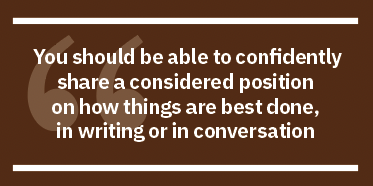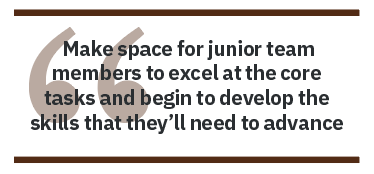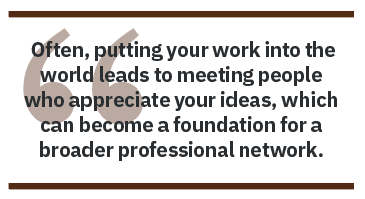By Cyd Harrell
Confidently navigate a mid-career transition to senior UX roles
There are hundreds of resources for people who want to get into content, or any field of design. But as a senior user experience (UX) person who spends time each week on mentorship, I’ve found that mid-career can be just as confusing and challenging a time as the start of a career. People with (approximately) 5–12 years of experience often go through another round of stuckness. They need to figure out how to do more with their design discipline, and how to have more influence in order to reach the truly senior level where they’ll have greater autonomy and recognition, and usually better pay and career satisfaction.
If that sounds like you, then this essay, adapted from a talk I first gave at UI’23 in Boston in 2018, is for you.
Becoming an Authority
The hallmarks of a truly senior job, whether it involves formal management responsibilities or not, are that it requires you to shape practice, to lead people, and to represent your discipline to larger internal groups. (If you’re lucky, you may also be asked to represent your discipline externally.) How well senior people do these things determines how much a team can accomplish. You can also continue advancing parts of your craft, but even in a non-management role these capabilities become central and being especially advanced in craft is optional.
All of these areas overlap, but let’s start with shaping practice. First and foremost, you need to have a perspective. This is a significant change from earlier career stages where you have less power and it can be dangerous to be opinionated. A senior practitioner is expected to be their own authority on good practice.
What does that mean? Well, an incredibly common question in senior interviews is “what’s your approach to X?” where X might be anything from style guides to migration to organizing content teams. Whereas at an early career stage you either wouldn’t be asked or would be expected to affirm that you’re compatible with what the organization has already chosen, now hiring managers are looking to find out about you. Strong, grounded opinions can tell you and your interviewer a lot about whether the role will be a fit for you.
You should be able to confidently share a considered position on how things are best done, in writing or in conversation, and sometimes to cite others you do and don’t align with (there’s never only one right way, but take a position).
At the same time you need strong opinions, you need to be self-aware. The more an area is in your wheelhouse, the stronger and more nuanced your approach should be. As a UX researcher, I have whole buckets of opinions about study design, but since I usually work in smaller organizations, ResearchOps (ReOps) tooling for large teams is an area I’m less versed in. In an interview, I can acknowledge that and say I’d love to work with a ReOps expert while still getting into depth about how to apply ethnographic methods remotely.
Identifying Your Perspective
You probably have a perspective on great content practice, but if you’ve had to subsume it to go along at earlier levels, it might take a little work to unearth it. Here are a few questions to get you started:
- Which practices have you seen succeed or fail? In what context?
- What can you articulate about why?
- What do the practitioners you most admire do wrong?
- For failed practices, was it a bad practice? Was it implemented poorly? Was the context not right? How do you think it might work under different conditions?
What’s great about developing a strong perspective is that it’s very useful for guiding your day to day work as well.
The Importance of Transparency
 One of the other characteristics of a strong senior is transparency — they don’t mystify their work and in fact most of the best go out of their way to make sure anyone who cares can understand why they make each choice. This is useful for teaching within the team, for modeling openness to challenge, and for expanding the group of people within an organization who understand the work and its impact.
One of the other characteristics of a strong senior is transparency — they don’t mystify their work and in fact most of the best go out of their way to make sure anyone who cares can understand why they make each choice. This is useful for teaching within the team, for modeling openness to challenge, and for expanding the group of people within an organization who understand the work and its impact.
Many seniors put as much effort into communicating the work as they do into practicing, which has the effect of strengthening the practice through broader understanding. They may employ all kinds of methods for this from office hours to wall work, but the important part is their perspective is in the open.
To get started, think about:
- If an engineer or a senior business leader came by, how would you explain what’s going on? What about an intern?
- What is your secret sauce? Can you explain it any better than “secret sauce”?
- Are there people in your organization who do content work without the title? How could you connect with them?
Types of Leadership
Leading people comes in two flavors, and you can do them both whether you formally take a management role or not. Mentoring is helping individuals level up their work — you’re probably already doing this, but as you begin to approach a senior status, it can be helpful to be intentional about it. Coaching, on the other hand, goes hand in hand with shaping a team’s practice — it means setting the conditions for a group of people to do fantastic work. There are player-coaches and coaches who are several steps removed, but I’m talking about the work that makes it possible for a team to excel.
As you move into more senior roles, you won’t necessarily have to stop being a content practitioner, but you will almost inevitably find yourself doing less of the easy tasks where you have the highest, most comfortable competence. It’s important to remember that this is because your refined skill set is needed for the harder tasks.
If you think of crafting great copy for the context as the central bread-and-butter task in content (debatable, I realize), you’ll find senior people doing less and less of it. Instead, they’ll be involved in more difficult-to-evaluate tasks like:
- Developing and documenting different facets of the organizational voice
- Standardizing content audits
- Integrating with business, design, and release flows
 You could consider all of these related to systems of governance and communication; they’re less tangible, but the core task can’t be done without them. And each of them presents opportunities to show more junior team members how all this works. As you step back from the center, you make space for them to excel at the core tasks and begin to develop the harder skills they’ll need to advance. Make space for junior team members to excel at the core tasks and begin to develop the skills that they’ll need to advance
You could consider all of these related to systems of governance and communication; they’re less tangible, but the core task can’t be done without them. And each of them presents opportunities to show more junior team members how all this works. As you step back from the center, you make space for them to excel at the core tasks and begin to develop the harder skills they’ll need to advance. Make space for junior team members to excel at the core tasks and begin to develop the skills that they’ll need to advance
To get started:
- How can you support people doing the content tasks that are easy for you?
- How can you make the hard tasks accessible to more people?
- Where do you need to stay hands-on?
- Can you come up with guidelines or principles for your team’s practice in certain areas?
Mentorship, helping an individual, is one to one and much more personal. You may choose to do it inside or outside of work, but I know few senior people who don’t spend some of their time helping their field by helping others. This means setting aside time to share your knowledge and really thinking about how you want to use that knowledge to create opportunities.
Your mentoring practice could be internal to your company or even your team, or it might focus on helping people level up a specific skill; you might prefer long term relationships or one-off sessions.
To get started, think about:
- Would you like to see the population of your field change (at your organization or outside)?
- What type of questions can you answer confidently?
- How much time is realistic for you to spend?
- How will people who need help find you?
No One Leads Alone
Finally, there’s the reality that no one leads alone. A senior practitioner can have some of their greatest impact as a strong teammate to other leaders. That can mean bringing a content (or broader design) perspective to any team conversation, or identifying ways for content and editorial to support larger goals. It also means contextualizing business, design, and technical decisions for the content team. All of this work prepares you well to become a public advocate for your practice if you choose, but it means you will have less access to an internal community of peers who can check and support you. You’ll need a cohort of friends and fans outside your organization.
Leadership teams come in several flavors, from the C-Suite (if you should be so lucky) to group leads who manage a suite of products within the same discipline. Whatever level you’re working at, you’ll be co-leading with people from different practice and leadership perspectives and you’ll have a responsibility not just to advocate for content and language as key practices but to bring an understanding of business goals into the practice-shaping you’re doing with your team.
Start being a leadership teammate with:
- How much do you know about what your counterparts need?
- How much do you think they understand about your work and your team (if you have one)?
- How clear are the leadership team’s shared goals inside the content team? Can you help do better?
Somewhat unfortunately in my opinion, most design fields expect truly senior people to be “known” and this can be a daunting prospect. I prefer to interpret this loosely: It can mean known internally, or worldwide, or somewhere in between. A “talks and publications” résumé section is very common at these levels, but it’s important to know that internal blog posts, presentations, and awards all count here. These show that you’re contributing your knowledge back to the field and that it’s being valued.
 Often, putting your work into the world leads to meeting people who appreciate your ideas, which can become a foundation for a broader professional network. You may need this when you’re looking for your next job, but it’s also helpful, if you’re spending most of your time working with a multidisciplinary leadership team and shaping a practice for a more junior team, to have outside peers whose perspective you can rely on.
Often, putting your work into the world leads to meeting people who appreciate your ideas, which can become a foundation for a broader professional network. You may need this when you’re looking for your next job, but it’s also helpful, if you’re spending most of your time working with a multidisciplinary leadership team and shaping a practice for a more junior team, to have outside peers whose perspective you can rely on.
Start being more public with:
- What’s the most interesting story from a project you worked on in the last two years?
- What could your content design community learn from that story?
- What would you need to tell it well as a blog, presentation, or podcast?
How to Begin Your Journey
If this all sounds like work on top of work, you’re not wrong. I’d like to close by offering a few practices you can start now, to set your feet on the path to the senior level:
- Get a notebook (or a text file) and track your opinions as they come up.
- Free-write your best UX story. (Edit later.)
- Invite one person from outside design to your workspace.
- Write up a key underlying practice for your team.
After that, you might move on to:
- Get coffee with a content-designer friend and trade opinions until you’re comfortable saying them.
- Pitch your best story. Or try it out as a Twitter thread.
- Set up a regular time or place for open work.
- Decide how and who you want to mentor. Make the offer.
- Reflect on how you team with leadership peers.
Leveling up this set of capabilities leads to greater autonomy and influence. You’ll show up as a leader with a well-honed perspective, who shares their knowledge generously and helps others get the most from content design. Regardless of your specific skill set, everybody wants to hire this kind of person, everybody wants to work with this kind of person, and everybody is glad to listen and dialog with this kind of person. I can’t wait to see you there.

CYD HARRELL (cyd@cydharrell.com) is well known in industry and government for her creative approach to UX research and service design. Since 2012, working with the Center for Civic Design, Code for America, and 18F, as well as independently, Cyd has helped multiple executive- and judicial-branch agencies in the U.S. apply research techniques and user-centered practice to serving the public. Her book, A Civic Technologist’s Practice Guide, is an onboarding guide and survival manual for tech people joining public sector work. When not at the office helping public servants use design for good, Cyd is a mentor for mid-senior UX practitioners.


